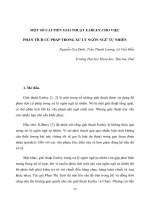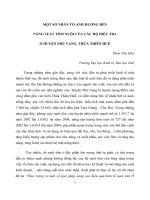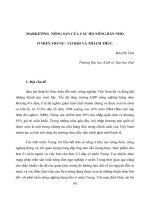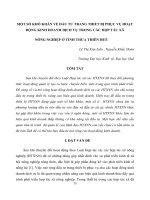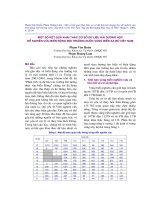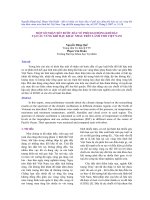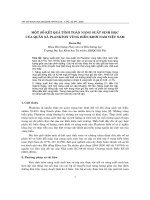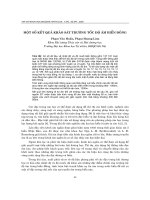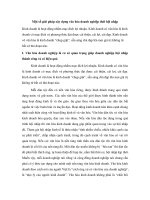Báo cáo nghiên cứu khoa học: "Một đánh giá của các phản ứng xử đối với dịch cúm A (H1N1) ở tỉnh Thừa Thiên Huế trong năm 2009" pot
Bạn đang xem bản rút gọn của tài liệu. Xem và tải ngay bản đầy đủ của tài liệu tại đây (289.48 KB, 16 trang )
93
JOURNAL OF SCIENCE, Hue University, N
0
61, 2010
AN ASSESSMENT OF THE TREAMENT RESPONSE FOR THE EPIDEMIC
OF INFLUENZA A (H1N1) IN THUA THIEN HUE PROVINCE IN 2009
Nguyen Dung, Hoang Huu Nam, Duong Quang Minh
Nguyen Mau Duyen, Nguyen Khoa Nguyen
Thua Thien Hue Provincial Health Department
Nguyen Dinh Son, Nguyen Thai Hoa
Thua Thien Hue Provincial Preventive Health Center
SUMMARY
The epidemic of Influenza A (H1N1) broke into Vietnam with the first case identified at
Ho Chi Minh City Tropical Hospital on 31
st
May, 2009. It quickly spread nationwide, with a
pattern of infection involving clusters of cases at schools, enterprises, and factories which
affected community activities and social security.The epidemic hit the Province at the end of
June, 2009 with the two peaks, one in September and mid-October and one in November. It then
gradually reduced at the end of 2009. The first patient, a Vietnamese Australian coming from
Australia, was hospitalized on the 24
th
June, 2009. After that, all of the District/City Health
Centers (DHC) organized an area to receive patients, and set up emergency groups for
treatment of influenza A (H1N1). Through an assessment of clinical progress of influenza A
(H1N1) cases, the provincial health network devised a strategy to limit infection in the
community, and limit the effects of the epidemic to the community and the departments/agencies
activities. The total number of patients hospitalized from 24
th
June, 2009 to 30
th
Decmeber, 2009
was 2,051 cases which were almost all mild, well monitored, and isolated for treatment. There
were 1,084 cases (52.8%) treated in hospitals, and 967 cases (47.2%) treated in controlled
communities. The number of communes with patients that provided organised treatment in the
community was 46%. Among 2,051 cases, the most affected age group was 10-19 (65.53%., The
highest rate was among pupils and students(79.5%). The mean time for fever resolving after
using Tamiflu was 1.75 days. There were no severe complications or deaths in the Province. The
epidemic was controlled in the Province; till early 2010, cases were only scattered, and
according to the evaluation indicators of a national focused influenza surveilance program in
Huong Thuy, the rate of influenza A (H1N1) was sharply reduced.
1. Introduction
The epidemic of influenza A (H1N1) arose in Mexico in April, 2009 and quickly
spread out worldwide, and had a global pandemic alert level of 6/6 according to the
WHO. According to the Announcement No. 83 from WHO, until 10
th
January, 2010,
there were more than 208 nations and territories that reported patients positive with
94
influenza A (H1N1), of which 13,554 died. Areas which had high infection of influenza
A (H1N1) in the community were North Africa, South Asia, East and Southeast Europe.
In Asian areas, there were reports of high deaths in some countries due to influenza type
A (H1N1) infection such as India (1,119), Japan (145), China (continent, 714), South
Korea (170), Australia (191), Thailand (196), and Malaysia (77). In Vietnam, the first
case was identified at the Ho Chi Minh City Tropical Hopsital on 31
st
May, 2009; until
20
th
January, 2010, Vietnam reported 11,166 positive cases, in which 56 were killed.
In Thua Thien Hue Province, the epidemic occured at the end of June, 2009,
with the two peaks, one in September, and one in mid October and November (15
th
and
17
th
weeks), it then gradually reduced in winter (November and December). At the
beginning of the epidemic at the end of June 2009, the first patient was a Vietnamese
Australian coming from Australia who was hospitalized on 24
th
June. After nearly two
months, the epidemic spread widely to the community, where a cluster of cases first
appeared in Huong Thuy district on the 14
th
August, 2009, and then many clusters of
cases appeared at schools such as Nguyen Hue and Gia Hoi High schools, and Vinh
Ninh Primary school. After that the disease spread out to many schools in the Province.
Patients were treated following the protocol of the Ministry of Health with the results of
recovery and no death.
Influenza A (H1N1) of type A was a communicable disease that was especially
dangerous. The disease was caused by a new virus of type A (H1N1). This was a new
virus which had not been reported before. This new virus had genetic materials from a
recombination of influenza viruses from pigs and birds (not H5) and humans. Especially
in Vietnam, there was circulation of avian flu, influenza A (H5N1), thus the risk of
patients might have been coinfected with the two strains of H1 and H5 influenza viruses.
This migh have resulted in the risk of recombination from genoms of the two virus
strains to form a new virus strain, which would be very dangerous due to its
characteristics of being transmitted easily like influenza A (H1N1) and being a serious
disease like influenza A (H5N1).
The organization of receiving treatment for influenza A (H1N1) patients that was
suitable to the local situation was an urgent problem, which required a feasible and
effective response which prevented deaths and avoided disruptions to the community
and other social activities. To ensure these needs were met, we conducted the following
study “An assessment of the treatment response for the epidemic of influenza A (H1N1)
in Thua Thien Hue Province in 2009” to describe the appropriateness of the
organization of the treatment response for confirmed and suspected influenza A (H1N1)
patients in Thua Thien Hue Province, describe some characterisitics of patients
diagnosed with comfirmed or suspected influenza A (H1N1) in Thua Thien Hue in 2009
and assess the results of the organization of treatment for influenza A (H1N1) in
controlled communities in Thua Thien Hue in 2009.
95
2. Methodology
2.1. Research subjects: All patients who were clinically diagnosed and treated
for influenza A at all hospitals in the province of Thua Thien Hue in 2009 including:
Suspected cases: Cases with fever (over 38ºC), having at least one respiratory
symptom such as upper respiratory infection, sore throat, cough, and having related
epidemiologic factors (close contact with confirmed cases; arrived or lived at
epidemiologic area; a cluster of cases)
Possible cases: Where a case with flu syndrome had laboratory tests positive
with influenza A but no confirmation of the type classification with tests for common
flu viruses.
Confirmed cases: Were the cases positive to influenza A (H1N1) with test Real-
time RT-PCR or RT-PCR
2.2. Research methodology: Cross -sectional combined with intervention
research.
2.3. Research period of time: The research was conducted during the period the
epidemic occured in Thua Thien Hue Province, from 24
th
June, 2009 to 31
st
December,
2009.
2.4. Implementation approach: A survey and treatment for influenza A (H1N1)
following Decision No. 2762 /QD-BYT dated on 31
st
July, 2009 by the Minister of
Ministry of Health on guidelines for diagnosis, treatment and prevention on spreading
influenza A (H1N1) with the two following periods:
2.4.1. Period before the epidemic spreading to community: From the 24
th
June,
2009 to 31
st
August, 2009, the disease happened sporadically, without clusters of cases
in the community, and treatment was organized through admission at Hue Central
Hospital and Hospitals of District/City Health Centers. The protocol for treatment of
influenza A/H1N1 from Ministry of Health was followed, while collecting data from
daily reports on cases from District/City Health Centers and Thua Thien Hue Provincial
Preventive Health Center.
2.4.2. The period when the disease spread to community: From 1
st
September,
2009 to 31
st
December, 2009, the disease quickly spread, and clusters of cases appeared
in the community and in schools in the Province. In order to deal with the situation, an
intervention to control the epidemic in the Province was implemented by the health
sector as outlined below:
2.4.2.1. An assessment was conducted on treatment for influenza A/H1N1 at
District/City Health Centers to determine clinical charisteristics of the epidemic.
2.4.2.2. The situation of the health network particitating in epidemic control and
96
prevention in the province was surveyed, including:
- National and departments/sectors level
+ Hue Central Hospital with experienced health staff had enough capacity to
direct the epidemic prevention as well as treatment admission for serious, complicated
cases. They had organized an isolated area for treatment admission designed one-
dimentionally following standards of Ministry of Health. They began with a scale of 20
beds, and has built a plan to meet a larger number of patients for screening and
treatment when required.
+ Hospitals: Hue University of Medicine and Pharmacy, Transportation, Military
Health 268 hospitals organized areas for screening check-ups of influenza A (H1N1)
and were ready to participate to meet the epidemic prevention when necessary.
- Provincial level: This included the Provincial Healh Department office,
Preventive Health Center, and Social Disease Prevention Center, which had enough staff
experienced in planning, directing, and organizing monitoring and management of
epidemics at all levels.
- District/City level
+ 100% of district hospitals organized isolated areas for treatment, designed one-
dimentionally following Ministry of Health standards, and had built a plan to meet a
larger number of patients for screening and treatment when required.
+ 100% of district hospitals had enough experienced health staff to treat
common and high risk flu cases.
+ 100% of district hospitals had enough health staff to participate in supervision,
support, treatment and management of epidemics in the community.
- Commune/ward/town
+ 100% of communes/wards/towns hhad doctors at Commune Health Centers
(CHC) who had been trained on epidemic surveillance, treatment and management, and
enough capacity to meet the treatment in controlled communities.
+ 100% of CHCs have enough health staff to participate in epidemic
management in the community.
2.4.2.3. Built a plan on treatment admission for influenza A (H1N1) in
controlled communities, including
2.4.2.3.1. Objective: Supervision for early detection, managment and treatment
of cases in the community. Ensuring treatment is in place for mild cases, referring for
more serious cases, ensuring safety for patients and limiting the spread of the epidemic
in the community.
97
2.4.2.3.2. Criteria on treatment of influenza A (H1N1) in controlled communities
All DHCs arranged a screening room for all cases of flu and respiratory
infection coming to the Centers for check-ups, or being referred from CHCs due to
suspected influenza A (H1N1). If there was a diagnosis of possible influenza A (H1N1),
tests, patient records and files, and consultations would be completed to confirm the
diagnosis, and the treatment would be conducted following the protocol of the Ministry
of Health. For those cases which were transferred to treat in a controlled community, the
following criteria were necessary to ensure:
Clinical disease conditions
- Having epidemiologic factors: Within 7 days, the patient:
+ Lived or came from areas with avian influenza A (H1N1) (especially in areas
where the epidemic spread out to community such as Hanoi, Ho Chi Minh City, Khanh
Hoa, and Dong Nai).
+ Living in localities with cases which were confirmedly diagnosed with
influenza A (H1N1)
+ Close contact with patients, or sources of disease: possible or confirmed
influenza A (H1N1)
+ Clusters of cases: Where there were many cases of people with influenza
infection or respiratory infections coming for check-ups within the same period of time.
- Having clinical symptoms: Acute progress with some following symptoms:
+ Fever (fever ≤ 39ºC)
+ Respiratory symptoms: Acute respiratory infection, sore throat, dry cough
(lungs without pathological sounds and no trouble in breathing).
+ No pathological background of chronic diseases (heart disease, diabetes,
asthma, chronic bronchitis, etc.)
+ No the elderly, children under 5 years of age, pregnant women
- Paraclinical tests: RT-PCR tests have confirmed positively for the virus strain of
influenza A (H1N1) (if conditions permit).
Conditions of family and patient: Treatment and measures to prevent infection
must be complied with. If there were not adequate conditions for infection control (no
isolation room, no antiseptic solution for cleaning supplies and treating personal effects)
or no commitment to treatment, the patient must be transferred to isolated areas at the
District/City Health Centers.
98
2.4.2.3.3. Organization of treatment in controlled communities
For District/City Health Centers
- Guiding and supervising CHCs to monitor and care for confirmed cases and
implementing treatment following the protocol from the Ministry of Health.
- Quickly assigning staff to coordinate with CHCs for timely referral of
complicated cases
- Arranging medical supplies, means of personal protection, sterilization
chemicals, etc. for CHCs to treat the confirmed cases.
- Organizing supervision and treating the environment at areas with confirmed
cases in accordance with the Ministry of Health regulations.
For Commune Health Centers
- Receiving suspected or confirmed cases of influenza virus A (H1N1) or people
with virus of influenza A which were eligible for the treatment in controlled
communities to be transferred from DHCs, and deligating qualified staff to monitor the
treatment of patients at home.
- Tracking the status of patients twice a day: fever, general vital signs, dyspnea
status, lung examination to detect abnormal sounds, general examination to detect new
diseases that might arise, etc. (write results in the patient’s records). If one of the serious
signs are detected such as fever over 39ºC, dyspnea, abnormal sounds in lungs or having
other abnormal progress, CHCs must promptly report to DHC and referred to upper
levels for appropriate treatment.
- CHC staff provide medicine daily for home treatment, to guide and monitor
patients on how to use medicine, and advise them on how to eat and rest, etc.
- Advising patients and their families about isolation, limited exposure, wearing
a mask, respiratory hygiene with ordinary antiseptic solutions, and routine hand
washing with soap containing antiseptic ingredients.
For patients and their family
- Must commit to and comply with the treatment and measures to prevent
infection, and arrange an isolation room, and antiseptic solutions to clean utensils and
treat personal stuff.
- In the course of treatment: patients must be isolated separately and exposure
must be limited, a mask must be worn when in contact or going out. Patients have to
sanitize their respiratory tract with ordinarily antiseptic solutions, use their own
personal utensils, and wash hands frequently with soap with antiseptic.
- They must clean the house daily with antiseptic solutions, keeping the doors
99
open.
2.4.2.3.4. Organization on surveillance and treatment of the epidemic in
community
Following Decision No. 1846/QD-BYT dated on 27
th
May, 2009 by the Minister
of Ministry of Health on guidelines on monitoring and prevention of the influenza A
(H1N1) epidemic.
2.4.2.4. Organization on implementing the plan of treatment admission for
influenza A/H1N1 in controlled communities, implementing monitoring and data
collection from daily reports of District/City Health Centers and Thua Thien Hue
Provincial Preventive Health Center.
2.5. Methods of data collection
- Data from daily reports of District/City Health Centers and Thua Thien Hue
Provincial Preventive Health Center.
- Results of serological surveillance in Nha Trang Pasteur Institute and the
National Epidemiology and Hygiene Institute.
- Synthesized data on the treatment of influenza A (H1N1) epidemic of
District/City Health Centers and Thua Thien Hue Provincial Preventive Health Center.
2.6. Data processing: Using Micosoft Office Excel 2003, SPPS 11.5.
3. Results and discussions
3.1. Description the suitability of the solution on organization of the treatment
admission for confirmed and suspected influenza A (H1N1) patients in Thua Thien Hue
Province
3.1.1. Description results of treatment on confirmed and suspected cases of
influenza A (H1N1) in hospitals before implementation of the treatment in controlled
communities:
Table 1. Treatment results of confirmed and suspected cases of influenza A (H1N1) in hospitals
before implementation of the treatment in controlled communities:
No. of cases
Age group
Total cases
(%)
Recovery
(%)
Complication
(%)
Mortality
(%)
< 9 years 3 (2.72) 3 (2.72) 0 0
10-19 years 65 (59.1) 65 (59.1) 0 0
20-29 years 27 (24.5) 27 (24.5) 0 0
30-39 years 5 (4.56) 5 (4.56) 0 0
100
40-49 years 5 (4.56) 5 (4.56) 0 0
> 50 year 5 (4.56) 5 (4.56) 0 0
Total 110 (100) 110 (100) 0 0
Among 110 cases which were screened and had a suspected diagnosis of
influenza A (H1N1) and were treated with Tamiflu recovered without complications
through monitoring. The age group most infected was 10-19 year olds, accounting for
59.1%, the age group 20-29 comprised of 24.5%, and the lowest rate was in children
aged less than 10 years. In the United States the age group of 0-4 was 19%, the age
group of 5-18 was 26%, the age group of 25-49 was 24% and those over 50 years of age
were 22%. This rate was consistent with epidemiological characteristics of how the
disease spreads when in direct and close contact, especially in crowded places such as
schools, factories, etc. There were two clusters of cases in Huong Thuy and Nguyen
Hue High School, which showed that the epidemic was spreading out to the community.
Table 2. Duration from using Tamiflu until ending fever of influenza A (H1N1) patients:
Duration of treatment until patients’
fever resolves
Number of
patients
Rate (%)
Fever ending right after hospitalization 18 16.36
Fever ending after one day 34 30.91
Fever ending after two days 46 41.82
Fever ending after three days 9 8.18
Fever ending after four days 2 1.82
Fever ending after five days 1 0.91
Average time for ending fever at patients after taking Tamiflu was 1.5 days (1:51
± 0.915), showed that the disease responded well to Tamiflu, progressing with mild
disease.
Comments: Influenza A (H1N1) had almost mild clinical condition, and
responded well to Tamiflu, which occurred mainly in pupil and student groups and was
spreading out to community.
3.1.2. Descripton the situation of the health network in the Province on the
prevention of influenza A (H1N1)
Thua Thien Hue Province is a specialized medical center of Central and
Highland areas with Hue Central Hospital, the hospitals of departments/agencies and
the health network of the health sector from the provincial to commune/ward/town.
101
Table 3. Distribution on capacity of the health network in the province in implementing the
prevention of influenza A (H1N1)
Level of treatment,
supervision, treating
epidemic
Treatment capacity for
influenza A (H1N1)
Capacity of operations
and supervision on
influenza A (H1N1)
prevention
Serious
disease with
complication
Mild
disease
with
risk
factors
Mild
disease
with
no risk
factors
Formulate
plans and
direct
epidemic
prevention
Implement
supervision
and
treatment
of
epidemic
National level Yes Yes Yes Yes Yes
Provincial level No No No Yes Yes
District/City level No Yes Yes Yes Yes
Commune/Ward/Town
level
No No Yes No Yes
The health network in the province ensured the implementation of the epidemic
prevention at all levels, especially at the grass roots health facility level to implement
the treatment for cases of influenza A (H1N1) which were mild and without risk factors.
The network had sufficiently professional and experienced staff in directing and
organizing the treatment, and monitoring the treatment of epidemics in the community.
3.1.3. Description the treatment admission model of influenza A (H1N1) when
the epidemic spread to community with large numbers of patients hospitalized every day
Table 4. Surveying impact possibility of the treatment admission models of Influenza A (H1N1)
when the epidemic spread to the community with large numbers of patients hospitalized every
day
Treatment
model
Mobilized
resources
Supporting
resources
Infection
controlling
capacity
Influence
possibilities
to daily life
and
community
activites
Influence
possibilities
to health
care at
health
facilities
In Hue
Central
In place No Controllable
Influence to
families,
relatives,
Cause
overload in
102
Hospital health staff hospital
In
District/City
Hospitals
In place
Provincial
level
Controllable
Influence to
families,
relatives,
health staff
Cause
overload in
hospital
In
community
under
control
(CHC)
In place
Provincial
and District
levels
Controllable
Little
influence
Little
influence
Field
hospital
Need to mobilize
participation of many
departments/agencies
Not well
controllable
Influence to
teaching and
study at
schools; stop
operations of
agencies, etc.
Cause
shortage of
human
resource at
health
facilities
mobilized to
participate
The response was according to the provisions of guidelines on surveillance and
prevention of influenza A (H1N1) in Decision No. 1846/QD-BYT and guidelines on
diagnosis, treatment and prevention of infection with influenza A (H1N1) in Decision
No. 2762/QD-BYT by the Ministry of Health. In order to investigate possible impacts
of the treatment admission model of Influenza A (H1N1) it has been shown that the
establishment of field hospitals in the treatment of influenza A (H1N1) required more
resources, particularly when a series of cases occured at many schools, enterprises,
factories, offices, etc., and influence social and community activities, as well as issues
of social security. The appropriate therapy model should have a low impact no health
care in hospitals, community activities and issues of social security. This was the case
with the approach in controlled communities.
Comments: The clinical progression and the spread of Influenza A (H1N1) was
surveyed, as was the capabilities of the health network. From this survey comparisons
of the effectiveness of the therapy solutions of influenza A (H1N1 ) were made and used
for provincial planning. Under the direction of the Ministry of Health and the Provincial
Party Committee, from 31
st
August, 2009, the Provincial Health Department used this
information to direct the implementation of plans regarding the organization of treating
influenza A (H1N1) in controlled communities in the province of Thua Thien Hue. The
aim was to reduce overload in hospitals, actively managing resources, limit exposure,
prevent the spread of disease and limit the influence of the epidemic on community
103
activities and social welfare.
3.2. Description some characteristics of influenza A (H1N1) in Thua Thien
Hue Province in 2009
3.2.1. Distribution on the treatment results of influenza A (H1N1) by gender
Table 5. Treatment results of patients with diagnosed or suspected influenza A (H1N1) in Thua
Thien Hue Province in 2009
No. of cases
Gender
Number of
cases
Number of
recovery
cases/ Rate
(%)
Number of
complicated
cases/ Rate
(%)
Number of
mortality/Rate
(%)
Male 1101 1101(53.7) 0 0
Female 950 950(46.3) 0 0
Total 2051 2051(100) 0 0
All of the 2051 treated cases responded well to Tamiflu, there no cases of
complications or deaths. Nationwide, the death rate was 0.5% [1] of which 43.59% were
under 15 years old, 82.05% were hospitalized after 3-10 days, 23.8% were pregnant
women, 54.7% had a history of chronic diseases; and 17.95% had history of
cardiovascular disease. The difference was not statistically significant between males
and females (P> 0.05), nationwide: 57.3% of cases were male, and 42.7% were female.
3.2.2. Distribution on the treatment results of influenza A (H1N1) by age group
19.11
65.53
7.31
3.07
0.15
0.07
0
10
20
30
40
50
60
70
Figure 1. Rate by age group (%) and confirmed and suspected cases of influenza A (H1N1)
which were treated in 2009
%
104
Among 2051 cases, the age group of 10-19 years was the most infected,
accounting for 65.53%, the age group of 20-29 years had 7.31%, and infection rates
were lower in the age group over 50 years. In the United States the age group of 0-4
years was 19%, the age group of 5-18 years was 26%, and the age group of 25-49 years
was 24%, and 22% for people over 50 years.
3.2.3. Distribution on the treatment results of influenza A (H1N1) patients by
occupation:
Table 6. The rate of treated influenza A (H1N1) patients by occupation
Occupation Frequency Rate (%)
Pupil 1635 79.72
Student 42 2.05
Staff 39 1.9
Young age 61 2.97
Worker, self-employed worker 149 7.26
Elderly 7 0.34
Teacher 33 1.61
Others 92 4.49
The highest rate was among pupils and students, accounting for 81.77% this is
similar to Canada, which had a rate of 71.4% amongst secondary school pupils (aged
13-17 years). The rate of spread was strong when in direct and close contact, especially
in crowded places such as schools and kindergartens.
Comments: For the treatment results of influenza A (H1N1) in the province of
Thua Thien Hue in 2009, clinical progress was mild, responded with Tamiflu, and with
no complications or mortality. The age group and occupation most affected was pupils
and students ,which was the group of people in the most crowded environment, which
facilitated the fastest spread of the disease.
3.3. Some evaluation on the effectiveness of organization on the treatment
admission for influenza A (H1N1) in controlled communities in Thua Thien Hue
Province in 2009
3.3.1. Progress on the situation of patients and phases of influenza A (H1N1)
epidemic
105
0
50
100
150
200
250
300
350
400
450
Tuần1(24
-
30/6)
Tuần3(6
-
12/7)
T5(20
-
26/7)
T7 (3
-
9/8)
T9(17
-
23/8)
T11(31/8
-
6/9)
T13(14
-
20/9)
T15(28
-
4/10)
T17(12
-
18/10)
T19(26
-
1/11)
T21(9
-
15/11)
T23(23
-
29/11)
T25 (7
-
13/12)
T27 (21
-
27/12)
Number of
…
Figure 2. Progress on the situation of patients and phases of influenza A (H1N1)
epidemic in 2009
The outbreak had two peaks in September and in mid-October and November
(the 15
th
and 17
th
weeks). In this period, the health sector implemented the uniform
treatment of influenza A (H1N1) in hospitals as well as in controlled communities,
while enhancing the monitoring and treatment of the outbreak. Therefore the outbreak
situation was controlled and gradually reduced in late 2009.
3.3.2. Evolution on the serological strains of influenza in Huong Thuy District in
2008-2009
Figure 3. Distribution on the serological strains of influenza through focused
surveillance in Huong Thuy in the years of 2008-2009.
Influenza B is usually most common in summer from March to May. Influenza
AH1 usually increases in autumn and winter months from July to December. Influenza
AH3 usually occurs in spring and summer months from January to July. In 2009, an
Initial phase
: Treatment
in hospitals
Spreading phase: Treatment in controlled communities
106
epidemic of the new Influenza A (H1N1) occured worldwide. The Influenza A (H1N1)
completely replaced the influenza AH1 and other influenza strains from July to October,
and decreased in November and then the influenza B and H3 recurrented.
3.3.3. Treatment results of patients in hospitals and in controlled communities:
Table 8. Distribution on the treated influenza A/H1N1 patients by district/city
No.
Location
Number of
commune having
patients
Number of commune
having treated
patients in community
Number of
patient
1 Phong Dien 10 4 88
2 Quang Diền 10 4 294
3 Huong Tra 14 5 361
4 Hue City 27 27 730
5 Phu Vang 20 1 152
6 Huong Thuy 12 6 266
7 Phu Loc 6 0 20
8 Nam Đong 10 1 80
9 A Luoi 13 8 58
10 Other provinces 0 0 2
Total 122 56 2051
The total number of hospitalized patients was 2,051 cases, which was distributed
through 122/152 communes/wards/towns across the province, with 56/122 of them
having patients treated in controlled communities, and a number of communes with
many patients, areas convenient for monitoring and treatment. The areas which had the
highest number of patients were Hue City, Huong Thuy and Huong Tra and the lowest
ones were A Luoi and Phu Loc.
Table 9. Treatment results of influenza A (H1N1) patients in hospitals and in controlled
communities
No. Location
Number
of treated
patients
Treatment levels and results
In
hospitals
Recovery
rate
(%)
In
community
Recovery
rate
(%)
1 Phong Dien 88 63 100 25 100
107
2 Quang Dien 294 183 100 111 100
3 Huong Tra 361 125 100 236 100
4 Hue City 730 420 100 310 100
5 Phu Vang 152 146 100 6 100
6 Huong Thuy 266 56 100 210 100
7 Phu Loc 20 13 100 7 100
8 Nam Dong 80 59 100 21 100
9 A Luoi 58 18 100 40 100
10
Other
provinces
2 1 100 1 100
Total 2,051
1,084
(52.8%)
100
967
(47.2%)
100
The treatment results in hospitals were 1,084 cases (52.8%) and in controlled
communities were 967 cases (47.2%), in which all recovered from the disease, without
complications or mortality. while all levels continued health care in health facilities and
health programs as planned.
Comments: Organisation for the treatment of influenza A (H1N1) in controlled
communities in the province of Thua Thien Hue has successfully treated 47.2% of
patients in hospitals, thereby reducing health facility overload at other levels (especially
in District/City Hospitals). The hospitals were deployed in parallel with routine health
care in health facilities in addition to, and not disrupting daily life or activities in the
community. The evaluation on progression of the disease situation in 2009 and the
results of the serological tests of influenza strains by focused surveillance in Huong
Thuy in the years 2008-2009 showed that the disease situation has been controlled and
decreased.
4. Conclusions
4.1. The identified characteristics of the epidemic of influenza A (H1N1), was
that it occurred mostly in the pupil and student group, and it spread rapidly through
direct contact, especially in crowded places. Cases were mostly clinically
mild, ,responded well to Tamiflu.
4.2. Solutions for the treatment of influenza A (H1N1) in controlled
communities in the province of Thua Thien Hue was consistent with the clinical
progression of the disease and the situation throughout the province. Treatment was
effectively administered for 47.2% of patients with influenza A (H1N1), and contributed
108
to minimising overload at higher health facility levels (especially at Central and District
levels), while limiting the impact of the epidemic to activities of the community and
departments/agencies. This facilitated stable social security and savings for the state
budget.
REFERENCES
1. Announcement No. 2694/TB-DPMT dated on 29
th
December, 2009 by Ministry of
Health on the situation of avian influenza A (H1N1).
2. Centers for Disease Control and Prevention 1600 Clifton Rd. Atlanta, GA 30333, USA
800-CDC-INFO (800-232-4636) TTY: (888) 232-6348, 24 Hours/Every Day -
3. Weekly epidemiological record. Relevé épidémiologique hebdomadaire. 20 November
2009, 84th year / 20 novembre 2009, 84e année.No. 47, 2009, 84, 485–492.
4. Guidelines on Diagnosis, Treatment and Prevention of influenza A (H1N1) infection
(Issued following Decision No. 2762 /QD-BYT dated on 31
st
July, 2009 by Minister of
the Ministry of Health).
